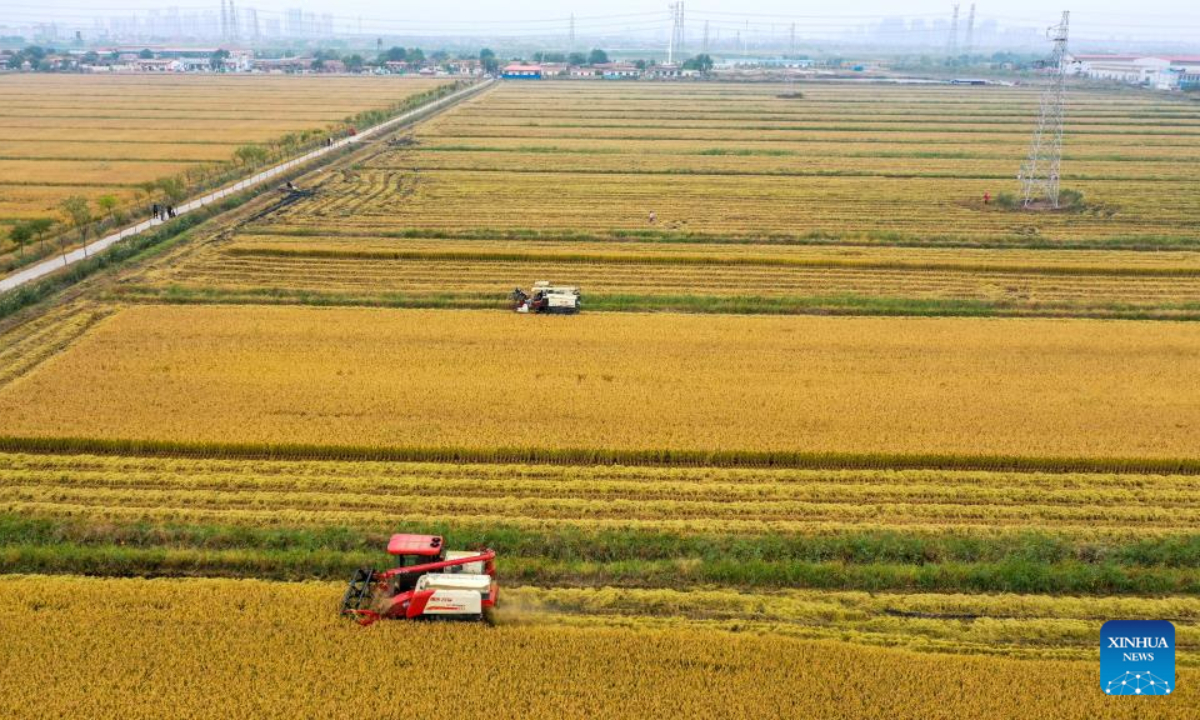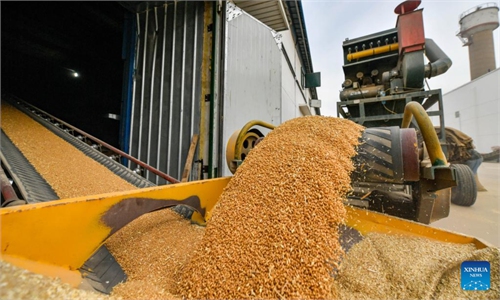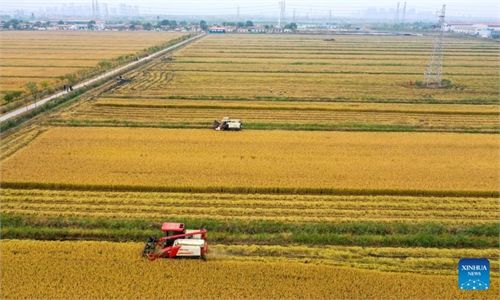China harvests more than 90% autumn grain, full-year bumper harvest expected: agriculture ministry
Timely supportive measures help mitigate drought in South China: expert

Aerial photo taken on Oct 13, 2022 shows a harvester working at a paddy field in Xiaozhan Town of Jinnan District in north China's Tianjin. Xiaozhan rice, which is a popular rice variety in China, is originated in Xiaozhan Town of Tianjin. Lately Xiaozhan rice has entered its harvest season. Photo:Xinhua
China has harvested 1.176 billion mu (78 million hectares) of autumn grain, roughly more than 90 percent of all autumn crops, official data showed on Sunday, a signal of another full-year bumper harvest despite unprecedented summer drought hitting the southern part of the country.
According to a survey from the Ministry of Agriculture and Rural Affairs released on Sunday, this year's summer grain output is 294.8 billion jin (147 million tons), an increase of 2.87 billion jin over the previous year, and the early rice output is 56.25 billion jin, an increase of 210 million jin.
"The impact of high temperatures and drought in the south of China is generally limited, and the growth momentum of autumn grain is the best in recent years," said the ministry.
Since autumn crops account for roughly more than 70 percent of the country's total grain output, a good summer harvest lays a solid foundation for the whole year, industry observers said.
Expansion of soybean- and oilseed-planting areas achieved major progress, especially in the case of soybeans, the ministry said. The area, unit yield and total output of rapeseed harvested during the summer all grew, and other oilseed crops such as peanuts and sunflowers showed a stable production trend.
The autumn and winter plantings are also progressing smoothly. At present, 80 percent of winter wheat and 70 percent of winter rapeseed have been sown, official data showed.
Drought and high temperatures inevitably weighed on crop yields, especially in some sloping and hilly areas that are inaccessible to timely irrigation, while major producing areas, such as Northeast China and the middle and lower reaches of the Yangtze River, remained in good condition, Jiao Shanwei, editor-in-chief of industry news website cngrain.com, told the Global Times.
The expert attributed the hard-won harvest to timely support, subsidies and coping measures tailored to local conditions from the central government, which helped minimize the impact of the extreme weather on the critical autumn harvest.
In August, China called for an "all-out battle" against high temperatures and drought to secure autumn harvest. Regions equipped for irrigation were asked to coordinate the allocation of water supplies, while agricultural households were encouraged to implement deep water cooling, small water irrigation, and running water to dissipate heat in accordance with local high temperature and drought conditions.
A farmer surnamed Hu with a planting base of 20,000 mu of rice in Wuhan, Central China's Hubei Province, told the Global Times on Sunday that his output fell about 5 percent mainly due to the drought.
Hu said that the local government had resorted to seeding clouds, maintaining pumping equipment and making other efforts to help farmers, and a one-time subsidy from the government helped to cushion the impact.
China's agricultural sector maintained sound development momentum in the first three quarters of 2022, with its value-added increasing 4.2 percent year-on-year to 5.48 trillion yuan ($755 billion), laying a solid foundation for the improvement of people's well-being and steady economic development, officials of the Ministry of Agriculture and Rural Affairs told a press conference on Saturday.
In the first nine months of this year, China continued to promote modern agriculture and earnestly carry out seed industry vitalization. The ministry has chosen 270 seed enterprises to accelerate core technological breakthroughs.
The country has established high-standard farmland of 71.66 million mu, accounting for 71.7 percent of this year's goal, according to the ministry.
The authorities continued to deepen rural reform and improve the living environment, with access to sanitary toilets in rural areas surpassing 70 percent. Moreover, the number of new types of business entities in rural areas has continued to rise, and the total number of cooperatives and family farms has exceeded 6.1 million.
For the farmers, secure harvests and higher incomes will further ensure China's food security, especially as uncertainties have been rising in the global grain trade and fluctuating commodity prices amid the Russia-Ukraine conflict, an independent industry analyst surnamed Chen told the Global Times on Sunday.
Food security was stressed by Chinese officials during the key 20th National Congress of the Communist Party of China held in mid-October. With a sound food security situation, "China has guaranteed that its food supply remains firmly in its own hands," Cong Liang, head of the State Grain and Reserves Administration, told a press conference on the sidelines of the congress on October 17.
While global food markets were unstable in recent years, China's market has maintained sufficient supplies and stable operations, effectively meeting people's needs and contributing to healthy economic development and social stability, Cong said, adding that China will remain well-positioned for ensuring food security.



